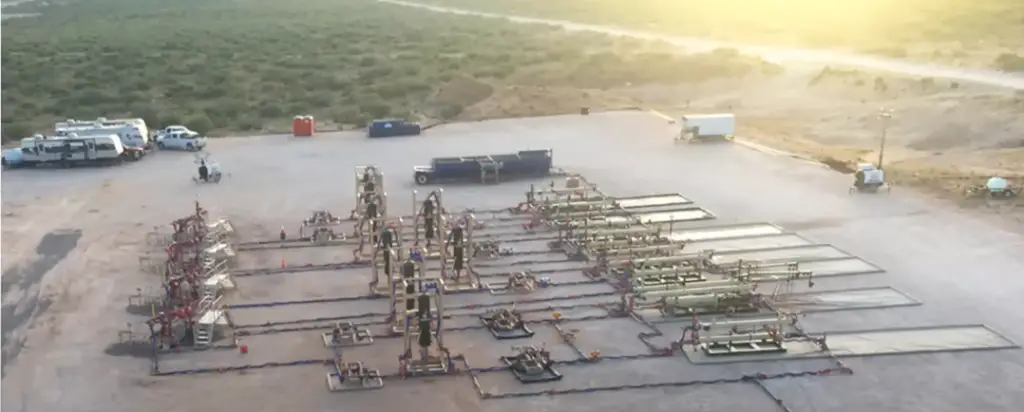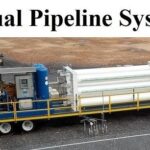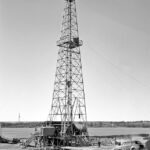The idea of a digital oilfield has been developing in recent years. There is an emphasis on how digital oilfield technology can be incorporated into existing oil and gas sector processes and workflows. The revolutionary effects of digital oilfield technology on oil companies are becoming increasingly apparent. Real-time data, cloud computing, and the Internet of Things drive innovation in digital oilfield companies by connecting the virtual and the tangible.
Moreover, increased output is possible in digital oilfields because of the requirement for automation. The term “automation” describes removing humans from routine tasks so that they can instead focus on more comprehensive and analytical projects.
Because of this, the digital oilfield is promoting the use of numerous technologies that integrate the collection of various types of operational data with substantial field knowledge to provide novel data-driven decisions. To realize the promised efficiency gains from digital oilfields, employing these cutting-edge digital oilfield technologies and programs will be necessary.
What are Digital Oilfields?
The digital oilfield represents the updated wave of digital transformation for the oil and gas industry. They use all the latest technologies like artificial intelligence (AI), the Internet of Things (IoT), augmented reality, mobile connectivity and the cloud. The digital oilfields are useful in helping operators gather, analyze, and react in real-time to production-related information in the field. Using the design and deployment of integrated workflows, digital oilfields maximize oilfield recovery, eliminate non-productive time, and increase profitability. The main advantage of oilfield digitization is that it automates the execution of all the tasks performed by cross-functional teams by combining business process management with advanced information technology and engineering expertise.
The digital oilfield technology that we see today comes from decades of experimentation and evolution. The first successful smart well was installed in the year 1997 in the Norwegian North Sea. Digital oilfields are also known as smart oilfields. A typical digital oilfield is expected to look as shown in Fig. 1.

Surveys show that the use of digital oilfield technologies has reduced power consumption by 18%, maintenance costs by 30%, and cutting inspection times by around 40%. So, digital oilfields are synonymous with maximizing the field’s operational efficiency.
Global Digital Oilfield Market is valued at $ 24.1 Billion in 2021. This is projected to reach a value of $ 34.7 Billion by the end of 2028 at a CAGR of 6.3% over the forecast period of 2022-2028.
Implementing Digital Oilfields by Oil Companies
Digital oilfield companies have received advancements due to digitalization in the oil industry. As new digital technologies are developed and incorporated into daily operations in the oil industry, businesses in this sector require a method to more easily access, understand, and analyze the massive amounts of data generated by these assets. Many intelligent gadgets’ diagnostics and other real-time data are now accessible via remote monitoring platforms.
Planning, developing, and deploying remote monitoring and operations management is the bedrock of digital oilfield technology. Using digital oilfields by various companies is discussed as follows:
1. Measurement of Important Wireless Data Transmission
Current devices in digital oilfield companies are often outfitted with the required hardware to permit continuous data gathering and storage in higher-level systems. Existing pressure, flow, level, and temperature monitoring points can be easily retrofitted with powerful wireless transmission technology, even in potentially dangerous areas.
The data can be sent to either a field control room or a central control room from anywhere in the world. To put it simply, this helps protect the planet and people. There is a significant amount of soil pollution caused by pipeline leaks since it usually takes too long to identify them. Additionally, wireless technology allows for the accessibility and functionality of emergency shower and eyewash facilities to be monitored.
2. Identifying Problems Leads to Greater Plant Productivity in the Long Run
Operators make substantial progress toward digital oilfield technology by collecting and analyzing their process data and the status data provided by digital field devices and intelligent pumps and compressors. The transition from reactive or preventative maintenance to predictive maintenance is one such method, as it reduces the need for personnel and replacement parts. There will be minimal maintenance needs and longer periods between equipment uses.
Oilfield operators might benefit from the knowledge the chemical sector has gained in recent years due to the possibilities of digitization.
3. Automation Improves Productivity and Quality
Efficient continuous data collection is a precursor to higher levels of automation in digital oilfield companies. For instance, the legally required API grade at the collection centers can be established by managing the pumps and control valves in the supplying pipes. Similarly, water separators can be set up for fully automated operation and upkeep. It is especially important to regulate water or gas injection systems to prevent a decline in oil production pressure.
4. Subsurface Measuring
Smart completion, also known as subsurface measurement, is inextricably related to the use of subsurface controls. Monitoring the reservoir’s pressure, temperature, or flow is essential to gain a deeper understanding of the reservoir and verify the accuracy of reservoir models. To maximize production/injection and enhance the recovery factor in digital oilfield companies, tracking the injection’s contribution to the formation is essential.
As a result, subsurface flow control devices improve hydrocarbon recovery because they allow for:
- Selecting and installing permanent down-hole gauges requires careful engineering analysis.
- Producing from more reservoirs with a smaller number of wells.
- Separating areas with high GOR or high water content.
5. Network for Transport in the Field
Operating firms have created and installed private transport networks over their oil and gas fields to meet the data, phone, and video transmission needs of the digital oilfield. One of the tried and true transmission technologies for private optical transport networks in digital oilfield companies is synchronous digital hierarchy (SDH), commonly employed in a ring topology.
More and more people depend on oils and products made from them, which increases the need for companies that offer digital oilfield services. To keep up with the skyrocketing demand from a growing population, oilfield services companies are coming up with innovative ways to increase output from oil-rich demographic zones.
Digital Oilfields Using Companies
The following list highlights some of the companies and services leading the way in the digital oilfield.
• Royal Dutch Shell
It is a global corporation Shell, which has its origins in both the United Kingdom and the Netherlands, was instrumental in developing the technologies that eventually led to the creation of the digital oilfield. At this stage, the company has been putting digital oilfield technology through its paces for several years in the testing phase.
Likewise, they have improved both their output and their recuperation rate while simultaneously cutting their downtime. The “Smart Fields” strategy that Shell is implementing at its sites worldwide is completely changing the oil and gas business. Shell is utilizing the products and services which offer technology and data analytics solutions, must provide to advance its digital transformation.
• Schlumberger
Schlumberger’s digital oilfield is at the forefront of technological progress in the oil and gas business since it is the world’s greatest technology provider for storage, penetration, production, and processing. It has established the gold standard for digital oilfield service providers everywhere, from exploration and development to the commercialization of “pore-to-pipeline” solutions. This applies to the whole industry. Schlumberger, an American company that provides oilfield services, operates in a diverse range of countries. In 1962, the Schlumberger brothers founded the corporation that bears their names. Olivier Le Peuch is now serving as the company’s chief executive officer. The company’s headquarters in the United States can be found in Texas.
Schlumberger Digital Oilfield is applying its extensive exploration and production processes knowledge to create digital oilfield solutions for risk mitigation and enhanced machinery diagnostics. These solutions are being developed using the company’s extensive knowledge of these processes. The companies Schlumberger and Rockwell Automation announced in February this year that they planned to create a joint venture called Sensia to develop software and hardware for Schlumberger’s digital oilfield automation.
• Halliburton
The oil and gas services company Halliburton was established in 1919 in the United States and maintained its headquarters in Texas. More specifically, the corporation conducts its business through two divisions, “Completion and Production” and “Drilling and Evaluation.” Digital oilfield companies like Halliburton offer services designed to increase the organization’s output.
In addition, it has a one-of-a-kind evaluation piece that offers first-rate solutions to the toughest problems facing the oil business anywhere in the world. They are distinguished from other prominent oilfield service providers due to this factor. Halliburton, an American company that provides services for the oil and gas fields, operates in more than 70 countries worldwide. In 1919, Erle P. Halliburton established the company that bears his name. Jeff Miller is the Executive Vice President and Chief Executive Officer. Where: in the U.S. state of Texas, the primary operation of the corporation is carried out by its wholly-owned subsidiary, Halliburton Holding Inc.
• Baker Hughes GE
Due to their merger, Baker Hughes and GE Oil & Gas now operate as single, streamlined service providers. Digital oilfield solutions, asset integrity, inspection devices, and oilfield machinery are the areas in which they excel in their expertise. The organization is at the forefront of innovation when it comes to the development of digital oilfield solutions. These services intend to keep track of everything from the drilling and well-completion procedures to the reservoir modeling, preventative maintenance, and asset monitoring activities.
Creating a Digital-first Oil and Gas Sector
Digital oilfield companies must completely embrace digital transformation to maintain their current performance and relevance in the foreseeable future. Energy Voice reports that the industry is still looking for answers to problems brought on by COVID-19, low oil prices, and the energy transition. If the oil and gas industry is to thrive in the future, digital oilfields and technological advancements will be vital. As a result, what actions should enterprises take to guarantee a sustainable digital environment for their oilfields?
1. Using Management Tools
Firstly, companies must leverage the many available Internet of Things management tools fully. Using specialized platforms like these makes automating data flow across various departments and tasks in an oil and gas company simpler. This includes, for example, production and asset management.
2. Development of Digital Oilfield
Secondly, digital oilfield companies will gain better insights, and the whole supply chain will improve by creating a fully digital oilfield. Most significantly, oil and gas companies will have an alternative solution to the traditional operations and infrastructure they have always relied on, thanks to cloud computing and data. Digital oilfields act as a wide-area network (WAN) connecting disparate parts of a company, allowing instantaneous data and information access. There is a growing recognition of technology’s role in the oil and gas business, and the digital oilfield is poised to play a major role in shaping the sector for the foreseeable future.
Benefits of Digital Oilfields
Oil companies need to maximize return on investment, productivity, and safety by making the most of the data analytic capabilities offered by their IT infrastructure. Whether protecting the environment or keeping a competitive edge, digital oilfield technology helps firms maintain their position.
Additionally, data collection is facilitated by a digital oilfield, which is useful for E&P company choices. The oil industry has several potential benefits from using a digitized oil field. Various benefits are discussed below:
• Quick Statistics
Currently, we are living in the information age. No physical proximity is required for conversation. As the era of cheap oil winds down, companies will need to start thinking about how best to take advantage of the emerging digital oilfield to maintain or increase efficiency and bottom-line profitability. Safer and more efficient operations produce more in less time, increasing earnings potential. Most of the data may be delivered in real-time, allowing for faster decision-making by managers and fewer distractions for employees.
Because of their superior latency and capacity, DOFs prefer wireless networking and high-speed communications to traditional satellite very-small-aperture terminal (VSAT) technologies.
To boost productivity, organizations can do several things, including increasing the performance and reliability of their assets and decreasing the need for unplanned maintenance. In digital oilfield technology, some techniques such as real-time controls, distributed analytics, and automated procedures can achieve this.
• A Proper Structure
Because it leverages data and current IT infrastructure, digital oilfield technology adoption in the oil industry can improve and enhance return on investment. Successful DOF adoption has many advantages, such as reducing deployment costs and increasing the value of legacy systems and IT investments. The provided decision support framework simplifies operational decisions and speeds up decision-making.
• Quickly Deployable
When an oil and gas company wants to test cutting-edge technology, one of the main challenges is the lengthy deployment times. You must put money into investments, and you can only expect a return for a short time.
It is only natural for a company to desire to see a profit as soon as possible, especially if doing so is within reach. DOF adoption and deployment may take a few weeks instead of months. Remember that data quality can and will improve over time due to increased transparency and process feedback. To achieve this, it is necessary to pave the way for the creation of additional value.
As a result, collaborating groups by integrating data across teams and disciplines, from automation engineers to data scientists, digital oilfield facilitates greater cooperation and communication, resulting in quicker and more informed decision-making.
Digital Oilfield Technology Solutions
For many years, the digital oilfield business has benefited from the advice of Digital Oilfield Solutions, a consulting organization. Because of their extensive background, they can provide invaluable insight. Services cover the entire lifecycle, beginning with drilling and ending with operations and maintenance. Through the help of the company, real-time, remote operations using industry-standard technology can be established. Some digital oilfield solutions are given below:
- Oil business owners and smart investors will do anything to conserve cash and prepare for the worst.
- The most prudent move now is for even “fortunate hedgers” like WPX and HES to significantly reduce CAPEX investment.
- If this situation lasts more than 90 days, further cuts to G&A will be required after recent cuts to CAPEX. It’s a disturbing truth to have to face.
- To survive such severe price fluctuations, Shale must move away from its current “dipping its toe in the water” strategy and instead prioritize the widespread adoption of digital oilfield technology. A similar case can be made for incorporating digital oilfield technology into every phase of the value chain.
- Those in high positions will keep getting richer like Schlumberger’s digital oilfield. Due to the present industry-friendly tax legislation, companies with healthy balance sheets and substantial cash reserves will develop a thorough plan to acquire assets.
Conclusion
Some of the most advanced digital oilfields in the world are now being implemented by multinational corporations, including BP, Chevron, and Equinor. Several major players in the oil and gas sector are investing heavily in the study and creation of technologies that will facilitate the sector’s increased digitalization.
Like, the advent of digital oilfield technology has allowed oil and gas producers and service providers to keep an eye on vital production processes from a wider distance. These technologies aim to increase hydrocarbon recovery rates and decrease equipment downtime in the oil and gas exploration and production (E&P) sector.
FAQs
Which service provider provides the most effective platform for building a digital oilfield?
This is doable if the oil and gas industry can settle on a trustworthy foundation for building the digital oil field. The Alpha Trans Form is a great resource for reaching this objective. It’s one-of-a-kind because it allows for rapidly creating mobile-friendly forms and field apps that link to and use preexisting data sources and web services. Its main goal is to develop mobile apps for the oil and gas business specifically designed for use in the field and can function without an internet connection.
Why don’t organizations utilize digital oilfields on a more regular basis?
Disruption-of-function (DOF) implementation has its own unique set of difficulties. The issue is that established energy sectors like oil and gas are reluctant to finance startups. It’s more difficult to find oil fields than in the past; deepwater oil exploration and oil exploration in remote regions further add to the difficulty.






